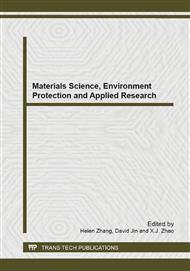[1]
Huang Buzhou, Pan Baozhi, Li Zhoubo. The recognition of gas-bearing tight sandstone/gravel reservoirs at the deep of xujiaweizi in daqing. Journal of jilin university(earth science edition) Vol. 33 (2003), p.490.
Google Scholar
[2]
Wang Zhuwen, Liu Jinghua, Xu Yanqing. Gas producitivity prediction for tight sandy gravel formation in the Daqing oilfield. Journal of jilin university(earth science edition) Vol. 33 (2003), p.485.
Google Scholar
[3]
Gao Boyu, Peng Shimi, Liu Hongqi. Fine log interpretation model for conglomerate reservoir in menggul in area. Well logging technology Vol. 29 (2005), p.5.
Google Scholar
[4]
Li Liang, Song Ziqi, Yu Xiaolong, et al. Comprehensive Evaluation of Conglomerate Reservoir of 7th Tract in Karamay Oilfield. Well logging technology Vol. 30 (2006), p.438.
Google Scholar
[5]
Dong Jingli, Zhang Jinyan. The Evaluation Tcehnique of the Gas Reservoir of Glutenite Reservoir in North Region of Dongying. Well logging technology Vol. 31(2007), p.216.
Google Scholar
[6]
Lu Hong, Li Jianmin. A kind of practical effective thickness interpretation and evaluation method for glutenite reservoirs. Petroleum Geology & Oilfield Development in Daqing Vol. 26( 2007), p.135.
Google Scholar
[7]
Zhao Hui, Sima Liqiang, Wu Xuegang. A study of identifying natural gas using logging dataine log interpretation model of sand and shale strata in the bei 16 area. Joumal of southwest petroleum university(science & technology edition) Vol. 31 (2009).
Google Scholar
[8]
Lu Mian. Study on the well logging interpretation method of glutinite reservoir lithology in xingcheng gas field. World well logging technology Vol. 23(2008), p.15.
Google Scholar
[9]
Luo Shuiliang, Lin Chengyan, Yuan Xueqiang, et al. Fine logging interpretation models and application for glutenite reservoir in Binnan oilfield. Computing techniques for geophysical and geochemical exploration Vol. 31(2009), p.130.
Google Scholar
[10]
Guoming. Logging comprehensive identification technology of deep sandy conglomerate lithology, dongying sag. Well logging technology Vol. 34 (2010), p.168.
Google Scholar
[11]
Chen Depo, Chen Ganghua, Wu Suying, et al. On oil-water layer identification method for deep glutenite reservoir with ultra-low permeability. Well logging technology Vol. 34 (2010), p.146.
Google Scholar
[12]
Shen Benke, ZhaoHongbing, Cui Wenfu, et al. Sandy conglomerate reservoir logging evaluation study. Progress in geophysics Vol. 27 (2012), p.1051.
Google Scholar
[13]
Jin Xueying. Identification of lithology logging in glutenite reservoir in shahezi group of xujiaweizi fault. Journal of northeast petroleum university Vol. 37 (2013), p.47.
Google Scholar


